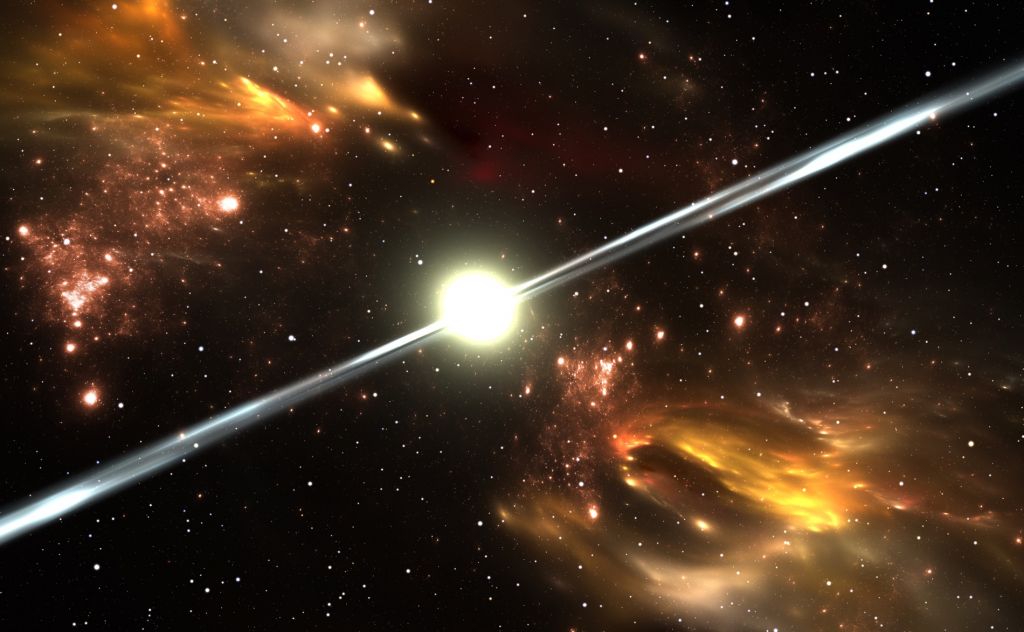One of the Fastest-Spinning Stars in the Galaxy Is Spitting Out Gamma Rays

A neutron star that spins at an unimaginable rate of 707 times per second also shoots out powerful pulses of gamma rays into the universe.
The star is at least 4,400 light-years from Earth, though its exact distance is a mystery (more on that later). The celestial body is what is known as a pulsar, a dense, rapidly spinning neutron star left behind by the collapse of a giant star. Pulsars have strong magnetic fields, and as they rotate, they spit out beams of radiation along their two magnetic poles. Much like a lighthouse beam, these streams can be seen by Earthlings only when pointing right at Earth, so pulsars appear to blink.
The newly discovered pulsar has the distinctly non-charismatic moniker PSR J0952-0607. The star was originally detected in 2017 by the Fermi Gamma-ray Space Telescope, according to the Max Planck Institute for Gravitational Physics, but no gamma-ray bursts were initially detected. However, the radio telescope array Low-Frequency Array detected pulsating radio signals from the star, which allowed scientists to work out a few preliminary details: J0952-0607 is part of a binary-star pair, orbiting a common mass in 6.2 hours per orbit with a buddy star a 50th the mass of the sun. The pulsar's rotation rate of 707 times per second makes it the second-fastest neutron star ever discovered. (The fastest, reported in the journal Science in 2006, rotates at 716 turns per second.)
Related: 15 Amazing Images of Stars
Gamma-ray search
Uncovering J0952-0607's gamma-ray beam was a trickier project. Researchers led by Lars Nieder, a doctoral student at Max Planck, used a supercomputer called Atlas to search eight years of data from the Fermi gamma-ray telescope for faint signs of the star's electromagnetic beam.
"This search is extremely challenging, because the Fermi gamma-ray telescope only registered the equivalent of about 200 gamma rays from the faint pulsar over the 8.5 years of observations," Nieder said in a statement. "During this time, the pulsar itself rotated 220 billion times. In other words, only once in a billion observations was a gamma ray observed!"
Related: The 12 Strangest Objects in the Universe
Get the Space.com Newsletter
Breaking space news, the latest updates on rocket launches, skywatching events and more!
Fortunately, the researchers were able to detect these lucky missives, confirming that J0952-0607 really is a pulsar. But they discovered a whole new set of questions about the extreme neutron star.
Stellar mysteries
The first surprise is that the Fermi gamma-ray telescope didn't detect any gamma-ray pulsations from the neutron star prior to July 2011. Perhaps the pulsar's orbit changed so that its beams became visible to Earthlings; but Nieder and his colleagues couldn't find any evidence of orbital alterations. It's also possible that the amount of gamma rays being emitted from the pulsar changed, but the scientists can't test that idea given the already-subtle signal of the faraway star.
Another mystery: How far away is the pulsar really? Optical telescope observations revealed that the pulsar's companion star is locked in a galactic dance with the rapidly spinning pulsar, with the same side of the star always facing its hyperactive companion. (The heat difference between the sides of the star — caused by this interaction — is detectable from Earth.) But while radio measurements suggest that the pulsar and its companion are 4,400 light-years away, optical measurements suggest that they're more like 13,200 light-years from Earth. It's unclear which is correct or why there is such a large difference between the measurements.
The distance matters: If the optical measurements are right, the pulsar's companion star likely fits into an expected density, at least based on past measurements of pulsar systems. If the radio measurements are closer to correct, the companion would have to be extremely dense, in a range never seen before in a pulsar companion.
Researchers are now collecting more Fermi gamma-ray observations to address this question. They published their findings on the new pulsar on Sept. 18 in The Astrophysical Journal.
- 9 Ideas About Black Holes That Will Blow Your Mind
- Spaced Out! 101 Astronomy Images That Will Blow Your Mind
- 11 Fascinating Facts About Our Milky Way Galaxy
Originally published on Live Science.

Join our Space Forums to keep talking space on the latest missions, night sky and more! And if you have a news tip, correction or comment, let us know at: community@space.com.

Stephanie Pappas is a contributing writer for Space.com sister site Live Science, covering topics ranging from geoscience to archaeology to the human brain and behavior. She was previously a senior writer for Live Science but is now a freelancer based in Denver, Colorado, and regularly contributes to Scientific American and The Monitor, the monthly magazine of the American Psychological Association. Stephanie received a bachelor's degree in psychology from the University of South Carolina and a graduate certificate in science communication from the University of California, Santa Cruz.










